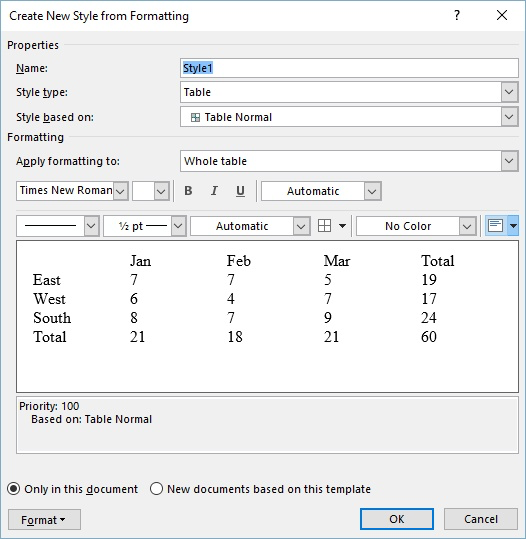Word For Mac User Defined Table Style Auto Format
Formatting Data Using the Locale Settings Different countries and regions have different conventions for formatting numerical and time-based information. Locale settings provide information about the formats used by the current user and must be considered when writing code that handles user-facing data types. The user sets the locale by choosing a region in Settings on iOS devices and System Preferences on a Mac. The user can also change locale settings while the app is running. Therefore, if you manipulate data objects in your code and then present them to the user, use the locale APIs to format the data correctly. You do not need to know how to format data in all the different locales. You can use preset styles that automatically generate locale-sensitive formats.
- Word For Mac User Defined Table Style Auto Format In Excel
- User Defined Table Type In Sql Server
- Grant Execute On User Defined Table Type
A user in the Microsoft Answers forum wanted to know how to use a Word macro to apply formatting to selected text in Outlook 2010. Outlook does not (and never had) a macro recorder but you can use some VBA code that was recorded in Word, in Outlook macros provided you reference the Word object model, and set the Word object and selection (as seen in the code below).
You can use custom formats as long as you convert them to locale-sensitive formats before presenting them to users. This chapter explains how to write locale-sensitive code. About Locale Formats Locales represent the formatting choices for a particular user, not the user’s preferred language. These are often the same but can be different.
For example, a native English speaker who lives in Germany might select English as the language and Germany as the region. Text appears in English but dates, times, and numbers follow German formatting rules. The day precedes the month and a 24-hour clock represents times, as shown in Table 4-1. Table 4-1 Data formats in United States and Germany Language (Region) Dates Times Numbers English (United States) Sunday, January 5, 2014 1/5/14 7:08:09 AM PST 7:08 AM 1,234.56 $4,567.89 English (Germany) Sunday 5 January 2014 05/01/14 07:08:09 PST 07:08 1.234,56 €4.567,89 On a Mac, you can preview modified locale preferences in System Preferences. When you choose a geographic region from the Region pop-up menu, samples of the date, time, and number formats appear.

This screenshot shows sample data formats when English is the language and Japan is the region: Mac users can also customize the formats of dates, times, and numbers by clicking the Advanced button, as described in. Using the Locale Object An object encapsulates information about the formatting standards of a particular region. When you format user-facing text, you pass an object representing the user’s selected region. The class provides class methods for obtaining the user’s locale object and other information about supported locales.
Getting the User’s Locale You can obtain the user’s locale using either the or class methods in the class. If you use the method, the property values of the returned object are guaranteed not to change. Therefore, use the method if you want to perform operations that need to be consistent.
Word For Mac User Defined Table Style Auto Format In Excel
If you use the method, the property values can change when the user changes the region settings. However, you are not notified if the returned object changes. To observe locale preference changes, read. NSString *currencySymbol = [[NSLocale currentLocale] objectForKey:NSLocaleCurrencySymbol]; For a complete list of locale property keys, see NSLocale Component Keys. Getting Localized Language and Dialect Names The identifiers that specify languages and dialects in APIs and folder names—for example, de-CH, en-AU, and pt-PT—shouldn’t be displayed to users. To get a human-readable, localized language or dialect name, use the method in the class, passing as the key parameter. To get the localized name for languages and dialects • Get the language that the app is using.
NSString *localizedString = [locale displayNameForKey:NSLocaleIdentifier value:languageID]; The format of the string is [Language] ([Dialect]). For example, if the language ID is de-CH, the localized language string is “Deutsch (Schweiz).” If the language ID is de, the localized language string is “Deutsch.” Getting Language-Specific Quotes Beginning and ending quotes, which vary in different languages, can be obtained from the locale object. Use the same technique, described in, to obtain the default locale for the language, and then use the locale component keys to obtain the language-specific quotes.
Endpoint url for office 365 airmail for mac. • Notify the system administrator about messages that contain malicious objects and/or filtered attachments.
User Defined Table Type In Sql Server
Grant Execute On User Defined Table Type
To create a string that uses locale-sensitive quotes • Get the language that the app is using. Best adblock for mac 2015. Table 4-2 Quotes in China, France, and Japan Region quotedString = @'%@iPhone%@' China “iPhone” France Japan Formatting Strings If available, use the alternative, locale-sensitive method for user-facing text. There are locale-sensitive methods for creating strings with formats, changing the case, obtaining ranges within a string, and comparing strings. How to print screen on mac. Creating Formatted Strings At a minimum, use the method in the class, not the method to format user-facing text. A simple fix to existing code is to replace occurrences of the method with the alternate method throughout your code, as in. NSString *localizedString = [NSString localizedStringWithFormat:@'%3.2f', myNumber]; This method uses the system locale.